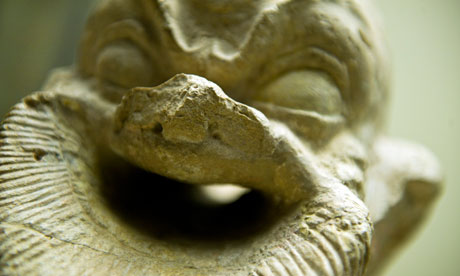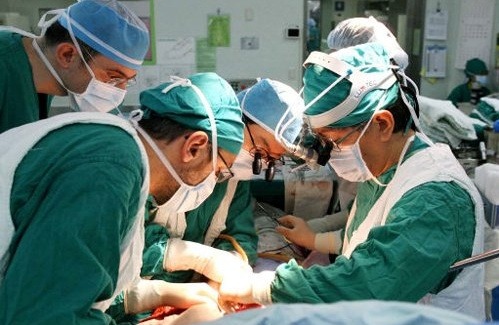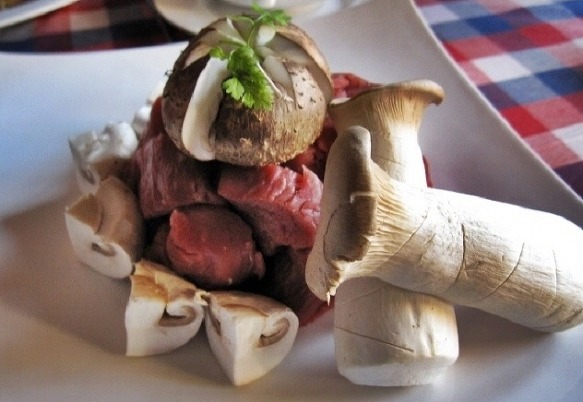The ghosts of ancient Afghanistan

In 1971, a team of French archaeologists discovered a sculpture in fragments at a site by the river Oxus in northern Afghanistan. It was restored and placed in the National Museum in Kabul. Then, a decade ago, it was smashed all over again, this time deliberately – by the Taliban, who were also demolishing the colossal Buddhas at Bamiyan, in the centre of the country. Those vast masterpieces of religious art are gone for ever, but this wonder of nudity was luckier. Afghan experts have now pieced it together again – and sent it around the world, to show off the richness of a country the world thinks of only as a vast alien battleground; or, in the subtle words of our defence secretary Liam Fox, "a broken 13th-century country".
The twice-rescued young man greets you at the start of Afghanistan: Crossroads of the Ancient World, the British Museum's compelling new show. There's no mistaking the beauty of this alabaster nude, who would be arresting even without his story of survival. The history of Afghanistan, this exhibition hints, is vast, complex and astounding. Its epic nature is shown by the fact that this show covers just a few ancient centuries, ending in the first century AD. But what centuries they were.
One of the most remarkable things about the youth carved in alabaster is the fact that he's an ancient Greek. How did he end up in Afghanistan? Well, he was found at an ancient Greek city discovered near the Oxus by French archaeologists in the 1960s. They partially excavated the city, clearly Hellenic in its art and architecture, until the Soviet invasion drove them away in 1979, leaving the site to be torn apart by looters.
Locals called the city Ai Khamun, Lady Moon, from a legend about a princess who lived in a fortress on the site. The remains of Lady Moon city, on show in this exhibition, are as stupendous as they are delicate. The huge flowery bloom of a Corinthian capital (the decorated top of a column) stands next to leaf-like terracotta ornaments overlooking a sundial shaped into a hollow sphere. A bronze Heracles, musclebound and fierce, is powerful proof that the Greek gods and heroes penetrated this far into Asia.
And only one man could have got them there: Alexander the Great. Consequently, although the original name for this city is not known, it can be guessed – some variant of Alexandria, perhaps. Ai Khamun is physical proof of the hold Alexander the Great has on history. Was he a monster or a genius, a visionary or just a talented general? Whatever, he tore through the borders separating east and west. In the fourth century BC, this Macedonian king led a Greek army into Asia to conquer the mighty Persian empire, then kept going, getting as far as India. He also got to the river Oxus, which is towards the border with China; and, in his mighty wake, this city grew up, a Greek colony with Greek art in the heart of central Asia.
A very saucy sofa
Afghanistan, says the country's president Hamid Karzai in the exhibition catalogue, "stands at the crossroads of many civilisations". You can't get more spectacular proof of this than a Greek city within a camel journey of China. In fact, camel journeys to and from China were the business of Afghanistan for centuries. Ai Khamun could not last: so far from the Hellenic heartland, this and other cities left by Alexander – which had made their money from trading on, or controlling trade along, the fabled Silk Road – were eventually overrun and wrecked by nomads.
In the archaeological museum of Naples in Italy, you can visit the Secret Cabinet: a collection of dirty pictures from the ancient Roman city of Pompeii. Surprisingly, the collection also includes an ivory carving of a cavorting love goddess from India. How did it find its way to Pompeii? This exhibition solves the mystery, placing a photograph of this carving next to identical ones found in Afghanistan, all with big round breasts, dancing, riding magical beasts, and generally displaying themselves.
These sensual Indian figures – most of them decorations for a sofa, not hard to guess its purpose – come from a hoard found at Begram, a little to the north of Kabul, near the route of the Silk Road. It is rare to find evidence of this fragile epic artery connecting ancient east and ancient west; rarer still to find evidence that's both beautiful and erotically animated. This dizzying collection of traded intercontinental treasures proves the Silk Road to be no fable: beautiful, expensive things really did journey between worlds, at a time when Romans knew nothing of the places they were connected to.
In between worlds, dominating the tough landscape of central Asia, ruling over poor farmers and moving in tented courts on horseback, lived the nomads, who hunted, kept pasture animals and fought fearsomely. Little survives of the world the nomads made: they were movers and shakers, not builders. Yet in 1978, Russian archaeologists in northern Afghanistan dug into a mound known as Tillya Tepe, "the hill of gold", and found it really was full of gold, nomad gold. It was the burial mound of a powerful nomad prince and five princesses: all were buried at the same time. The women were sacrificial victims, apparently, doomed to die with their master. Stand by your man – and get buried with him, too.
Something doesn't add up
So, rich and splendid as these nomads were, you wouldn't call them civilised. It is the gold of Tillya Tepe that features on the show's catalogue cover. Even without knowing why the princesses died, there is something savage and coarse about this gold. Compared with the Indian and Greek works, these are primitive, if still brilliant, objects. And yet the people who made them draw on ancient Greek and even Chinese art for inspiration. This gold hoard is, literally, a melting pot of cultures. Yet the mixing of Greek cupids and Chinese pastoral ornaments results in a strange and tasteless art, a bizarre, barbaric melange.
Yes, it is magnificent, but it's not a magical synthesis of cultures, more like a visual no man's land. Among the nomad gold, the exhibition's portrayal of Afghanistan as a "crossroads" becomes questionable. Goods were traded, but was any deep learning shared? Somehow it doesn't add up. Some Indian stuff went west. Some Roman glass went east. Yet the only people creating a postmodern bricolage of east and west were the nomads, scavengers on the borders of both east and west.
If east and west really had met in ancient times, the world would look very different. But that would have needed a deeper encounter: a true visionary, able to cross continents and join them. Now if Alexander had lived . . .
• Afghanistan: Crossroads of the Ancient World is at the British Museum, London WC1, from Thursday. Box office: 020-7323 8181.
Read more...













 It may be no surprise that Korean mushrooms with high quality and taste has successfully created its market in Swiss. It had past 3~4 years since Korean king oyster mushrooms joined the dishes of the Swiss dining table.
It may be no surprise that Korean mushrooms with high quality and taste has successfully created its market in Swiss. It had past 3~4 years since Korean king oyster mushrooms joined the dishes of the Swiss dining table.

















